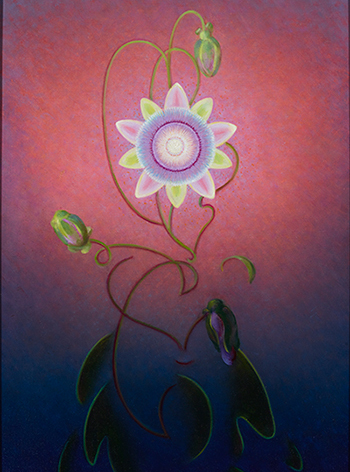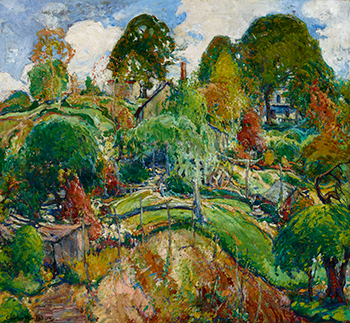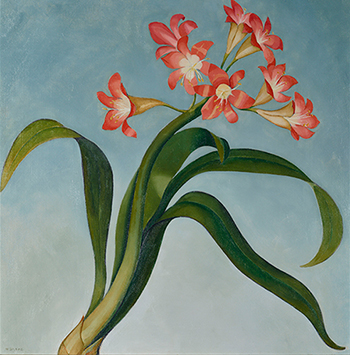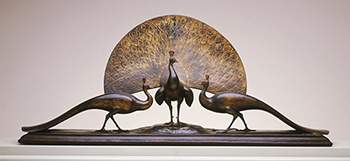Press Release - Three Works by Important California Painters and an American Art Deco Sculpture Join The Huntington's Collections
Posted on Fri., Dec. 16, 2016
SAN MARINO, Calif.— The Huntington Library, Art Collections, and Botanical Gardens announced today it has acquired three works by important 20th-century California painters as well as a significant American sculpture. Charles Reiffel’s intense 1916 expressionist landscape, Bit of Silvermine – The Old Farm House, Henrietta Shore’s lilting Clivia (1930), and Gaston Lachaise’s elegant bronze Art Deco masterpiece, The Peacocks (1918), were acquired in recent months. Passion Flower (1945) by modernist painter and founding member of the Transcendental Painting Group, Agnes Pelton, officially joined the collections this week. All four pieces currently are on view in the Virginia Steele Scott Galleries of American Art.
“We’ve been looking to add paintings by Pelton and Shore to the collections for some time, and the resplendent Reiffel, on loan to us for the past few years, has generously been made a gift to us,” said Kevin Salatino, Hannah and Russel Kully Director of the Art Collections at The Huntington. “What a pleasure it is finally to have acquired stellar examples by each of these artists. As for Lachaise’s great The Peacocks, it beautifully complements The Huntington’s growing collection of important American sculpture from the 18th to the 20th century.”
 Agnes Pelton, American (1886–1961), Passion Flower, ca. 1945, oil on canvas, 24 × 16 in.
Agnes Pelton, American (1886–1961), Passion Flower, ca. 1945, oil on canvas, 24 × 16 in.
Pelton was born in Germany to American parents, spent her early career in New York studying with Arthur Wesley Dow (with whom Georgia O’Keeffe also studied), and moved to Cathedral City, Calif., in 1932. At the time, Cathedral City was an isolated desert enclave, allowing the artist the mystical serenity she craved for her work.
In 1938, Pelton became a founding member of the Transcendental Painting Group (based in Santa Fe, N.M.), which was formed to promote non-objective painting and was influenced by Theosophy, Zen Buddhism, and other forms of non-Western thought. From the 1920s on, Pelton’s paintings became more and more visionary, and her technique, relying upon a complex layering of colors, developed an inner radiance that characterizes her finest work. About her, Los Angeles Times art critic Christopher Knight has written “Pelton infused an organic light into the otherwise machine-influenced Art Deco styling of the 1920s and 1930s, creating easel paintings that are like modern talismans of spiritual wonderment.
Pelton was the subject of a traveling exhibition, “Agnes Pelton, Poet of Nature,” in 1995, and was one of four female artists featured in the 2009 Orange County Museum of Art exhibition “Illumination: The Paintings of Georgia O’Keeffe, Agnes Pelton, Agnes Martin, and Florence Miller Pierce.”
Charles Reiffel (1862–1942), Bit of Silvermine – The Old Farm House, 1916, oil on canvas, 34 1/2 × 37 1/4 in.
 A highlight of the early 20th-century paintings on view in the Virginia Steele Scott Galleries of American art since their expansion in 2014, Bit of Silvermine – The Old Farm House is a gift of collectors Sandra and Bram Dijkstra, who previously donated Charles White’s painting, Soldier (1944) and Robert S. Duncanson’s Landscape with Ruin (ca. 1853) to The Huntington. Bit of Silvermine, painted nearly a decade before Reiffel decamped from the east coast to settle permanently in San Diego, has been called the breakthrough painting of the artist’s career. Its brilliant palette, expressionist landscape (set in the artist’s colony of Silvermine, Conn.), and vigorous brushstroke, make it a work attuned to contemporary movements in Europe.
A highlight of the early 20th-century paintings on view in the Virginia Steele Scott Galleries of American art since their expansion in 2014, Bit of Silvermine – The Old Farm House is a gift of collectors Sandra and Bram Dijkstra, who previously donated Charles White’s painting, Soldier (1944) and Robert S. Duncanson’s Landscape with Ruin (ca. 1853) to The Huntington. Bit of Silvermine, painted nearly a decade before Reiffel decamped from the east coast to settle permanently in San Diego, has been called the breakthrough painting of the artist’s career. Its brilliant palette, expressionist landscape (set in the artist’s colony of Silvermine, Conn.), and vigorous brushstroke, make it a work attuned to contemporary movements in Europe.
Well-known and highly regarded in his lifetime, Reiffel fell into obscurity after his death. The exhibition, “Charles Reiffel: An American Post-Impressionist,” held at the San Diego Museum of Art in 2013, helped to revive his reputation.
Bit of Silvermine joins a group of 20th-century American landscapes at The Huntington that include works by such iconic modernists as Edward Hopper, Arthur Dove, and Charles Sheeler.
 Henrietta Shore (1880 – 1963), Clivia, ca. 1930, oil and pencil on canvas laid down on board, 26 × 26 in.
Henrietta Shore (1880 – 1963), Clivia, ca. 1930, oil and pencil on canvas laid down on board, 26 × 26 in.
Another painter whose reputation suffered after her death, Shore also has experienced a surge of interest in recent years. In her lifetime she was frequently compared to Georgia O’Keeffe. But, unlike O’Keeffe, who made her career on the East Coast and was connected to the most influential avant-garde tastemakers, the Canadian-born Shore moved to Los Angeles in 1913, and quickly became a member of its vanguard art circles, which included modern dance pioneer Ruth St. Denis. Shore eventually befriended the photographer Edward Weston, to whom she allegedly lent the nautilus shell that became the subject of one of his best-known photographs.
In 1930, Shore followed Weston to Carmel, Calif. “It was in Carmel that she painted some of her most seductive and modernist works, among them Clivia,” said Salatino. “Its flame-colored blooms and sinuous leaves exude a vibrant sensuality through reductive form that defines many of her idiosyncratic images of the natural world. Clivia is an example of Shore at her best.”
 Gaston Lachaise (1882 – 1935), The Peacocks, 1918, bronze with gilding, 22 1/2 × 56 × 10 in.
Gaston Lachaise (1882 – 1935), The Peacocks, 1918, bronze with gilding, 22 1/2 × 56 × 10 in.
The French-born Gaston Lachaise emigrated to America in 1906 and became one of the most important early 20th-century American sculptors, especially famous for his large and powerful female nudes. Of the same generation as Picasso and Brancusi and a member of the most avant-garde circles of his day, Lachaise was the subject, in 1935, of the first Museum of Modern Art retrospective of a living sculptor.
Conceived in 1918, The Peacocks is one of Lachaise’s best-known and most popular sculptures, demonstrating his ability to seamlessly combine design with nature to create a work characterized by elegance, balance, rhythm, and dynamism. A total of 14 bronze casts were made of the work between 1922 and 1929, most of which are now in public collections, including those of the Metropolitan Museum of Art, Philadelphia Museum of Art, and the Detroit Institute of Arts. The sixth in the edition, The Huntington’s example was cast in 1924. The Peacocks joins other significant examples of early 20th-century modernist sculpture, including several works by Lachaise’s teacher, Paul Manship.
# # #
Contacts
Thea M. Page, 626-405-2260, tpage@huntington.org
Lisa Blackburn, 626-405-2140, lblackburn@huntington.org



